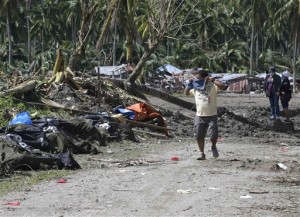
A resident covers his nose as he walks past typhoon Pablo’s victims which are left unattended at New Bataan town in Compostela Valley on Dec. 8, 2012. Almost a month after the typhoon wreaked havoc, officials urged residents to unite in the face of the daunting tasks of rebuilding and reconstruction. AP Photo/Bullit Marquez
NEW BATAAN, Compostela Valley—Almost a month after typhoon Pablo (Bopha) flattened this town on Dec. 4, officials here urged residents to unite in the face of the daunting tasks of rebuilding and reconstruction, admitting that it would take them some time to get over the loss of lives and property.
This whole idyllic town still lay in ruins and the stench of death still pervaded the air more than a month after the storm’s howling wind and torrential rains devastated Andap, a community of more than 2,000 people, claiming 400 lives.
“Honestly, we are not yet OK,” said Mayor Lorenzo Balbin. “People are still depending on assistance as we try to bring our lives back to what it used to be.”
Assistance from local, national and international relief agencies has been pouring in New Bataan since the catastrophe struck and people have been trying to live off it, Balbin said.
It was a Tuesday that Fretchel dela Victoria and other New Bataan residents would never remember.
Rumbling sound
“We heard a rumbling sound and then saw a tall wall of water roaring towards us. We ran as fast as we could, not minding if we had brought something other than the clothes we had on,” the 32-year old resident of Purok (Community) 3, Poblacion, which is near Andap, told the Inquirer as she and other residents did their laundry at a water pipe beside a flooded road leading to Andap.
Trees uprooted by Pablo’s 175-kilometer-per hour-winds choked the upper portion of Mayo River, creating an artificial dam, which eventually collapsed under the huge volume of rainwater that accumulated there, Balbin said.
“The collapse of the artificial dam created a high, wide wall of water that descended downstream, washing away communities below it,” said the mayor.
Residents who survived the disaster said they saw uprooted trees and boulders rolling with the wall of murky water “as tall as two full-grown coconut trees.”
“Like a tidal wave,” said 73-year old Carlos de la Torre, who along with his wife and at least 50 others ran off to a hill as floodwaters swept through the village. “I thought we would die that day.”
Denial
Local officials had denied that logging and mining aggravated the disaster, with Balbin saying in previous interviews the local government had banned such activities in the mountains around Andap.
The mayor pointed to the many things that should be done to bring back normalcy to the town.
All of New Bataan’s 16 villages suffered destruction as a result of the flood or the strong wind, or both.
“Homes are in shambles, people’s livelihoods still in disarray,” Balbin told the Inquirer at his office on the second floor of the municipal building, which sustained damage. “But we cannot lose hope. We have to rise again.”
As rebuilding and rehabilitation efforts continue, people in this town have slowly come to accept evacuation as part of their life.
Traumatized
People are so traumatized with last month’s storm, they become jittery at the first sign of rains, according to Marlon Esperanza, municipal information officer.
He said the local government, not wanting to take chances, has decided to enforce preemptive evacuation, whenever necessary.
At least 210 families or roughly 1, 000 individuals were evacuated from six communities in Poblacion and Andap village since Wednesday due to continuous rains, Esperanza said. The evacuees stayed in various schools, crowding further the evacuation centers still occupied by residents made homeless by Pablo, and putting off the resumption of classes last Thursday.
“We don’t want a repeat of the Dec. 4 disaster,” said Balbin, in ordering the forced evacuation.
Balbin said he has asked the government through Undersecretary Benito Ramos of the National Disaster Risk Reduction and Management Council (NDRRMC) to help the local government in the planned re-channeling of the Mayo River.
He said “correcting” the course of the river and de-silting it and other waterways would help manage the flow of water during rains and prevent flooding.
“We found out (during flooding) water already runs through roads instead on riverbeds,” said Balbin.
Rebuilding Compostela
Late last month, the provincial government has kicked off a campaign of rebuilding Compostela Valley.
Dubbed “Tindog ComVal: Walang Iwanan (Stand ComVal: Leave no one behind),” the advocacy exhorts Compostela Valley residents to unite and help one another rebuild, according to Gov. Arturo Uy.
“This is to rally the people to work together for us to move on,” said Uy.
The governor said the outpouring of support from different groups has helped residents in the devastated province focus their attention on rebuilding and rehabilitation.
In New Bataan, Balbin also urged his people to immediately buckle down to work, with aid still coming.
The two officials also expressed gratitude to various aid groups that have sent help
To compensate for the losses in agriculture—the province’s main livelihood—the government gave bags of seeds and seedlings for “quick cash crops” such as corn, cacao, palay and vegetables.